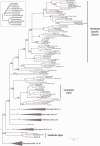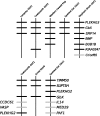Ancient Duplications and Expression Divergence in the Globin Gene Superfamily of Vertebrates: Insights from the Elephant Shark Genome and Transcriptome
- PMID: 25743544
- PMCID: PMC4476154
- DOI: 10.1093/molbev/msv054
Ancient Duplications and Expression Divergence in the Globin Gene Superfamily of Vertebrates: Insights from the Elephant Shark Genome and Transcriptome
Abstract
Comparative analyses of vertebrate genomes continue to uncover a surprising diversity of genes in the globin gene superfamily, some of which have very restricted phyletic distributions despite their antiquity. Genomic analysis of the globin gene repertoire of cartilaginous fish (Chondrichthyes) should be especially informative about the duplicative origins and ancestral functions of vertebrate globins, as divergence between Chondrichthyes and bony vertebrates represents the most basal split within the jawed vertebrates. Here, we report a comparative genomic analysis of the vertebrate globin gene family that includes the complete globin gene repertoire of the elephant shark (Callorhinchus milii). Using genomic sequence data from representatives of all major vertebrate classes, integrated analyses of conserved synteny and phylogenetic relationships revealed that the last common ancestor of vertebrates possessed a repertoire of at least seven globin genes: single copies of androglobin and neuroglobin, four paralogous copies of globin X, and the single-copy progenitor of the entire set of vertebrate-specific globins. Combined with expression data, the genomic inventory of elephant shark globins yielded four especially surprising findings: 1) there is no trace of the neuroglobin gene (a highly conserved gene that is present in all other jawed vertebrates that have been examined to date), 2) myoglobin is highly expressed in heart, but not in skeletal muscle (reflecting a possible ancestral condition in vertebrates with single-circuit circulatory systems), 3) elephant shark possesses two highly divergent globin X paralogs, one of which is preferentially expressed in gonads, and 4) elephant shark possesses two structurally distinct α-globin paralogs, one of which is preferentially expressed in the brain. Expression profiles of elephant shark globin genes reveal distinct specializations of function relative to orthologs in bony vertebrates and suggest hypotheses about ancestral functions of vertebrate globins.
Keywords: Chondrichthyes; gene duplication; gene family evolution; globin; myoglobin; neuroglobin.
© The Author 2015. Published by Oxford University Press on behalf of the Society for Molecular Biology and Evolution. All rights reserved. For permissions, please e-mail: journals.permissions@oup.com.
Figures





Similar articles
-
Parathyroid hormone gene family in a cartilaginous fish, the elephant shark (Callorhinchus milii).J Bone Miner Res. 2010 Dec;25(12):2613-23. doi: 10.1002/jbmr.178. Epub 2010 Jul 7. J Bone Miner Res. 2010. PMID: 20614475
-
Conservation of globin genes in the "living fossil" Latimeria chalumnae and reconstruction of the evolution of the vertebrate globin family.Biochim Biophys Acta. 2013 Sep;1834(9):1801-12. doi: 10.1016/j.bbapap.2013.01.019. Epub 2013 Jan 27. Biochim Biophys Acta. 2013. PMID: 23360762
-
Elephant shark sequence reveals unique insights into the evolutionary history of vertebrate genes: A comparative analysis of the protocadherin cluster.Proc Natl Acad Sci U S A. 2008 Mar 11;105(10):3819-24. doi: 10.1073/pnas.0800398105. Epub 2008 Mar 4. Proc Natl Acad Sci U S A. 2008. PMID: 18319338 Free PMC article.
-
Gene duplication, genome duplication, and the functional diversification of vertebrate globins.Mol Phylogenet Evol. 2013 Feb;66(2):469-78. doi: 10.1016/j.ympev.2012.07.013. Epub 2012 Jul 27. Mol Phylogenet Evol. 2013. PMID: 22846683 Free PMC article. Review.
-
Phylogenetic diversification of the globin gene superfamily in chordates.IUBMB Life. 2011 May;63(5):313-22. doi: 10.1002/iub.482. Epub 2011 May 9. IUBMB Life. 2011. PMID: 21557448 Free PMC article. Review.
Cited by
-
The Globin Gene Family in Arthropods: Evolution and Functional Diversity.Front Genet. 2020 Aug 13;11:858. doi: 10.3389/fgene.2020.00858. eCollection 2020. Front Genet. 2020. PMID: 32922435 Free PMC article.
-
The Full Globin Repertoire of Turtles Provides Insights into Vertebrate Globin Evolution and Functions.Genome Biol Evol. 2015 Jun 15;7(7):1896-913. doi: 10.1093/gbe/evv114. Genome Biol Evol. 2015. PMID: 26078264 Free PMC article.
-
Globin E is a myoglobin-related, respiratory protein highly expressed in lungfish oocytes.Sci Rep. 2019 Jan 22;9(1):280. doi: 10.1038/s41598-018-36592-w. Sci Rep. 2019. PMID: 30670817 Free PMC article.
-
The More, the Merrier? Multiple Myoglobin Genes in Fish Species, Especially in Gray Bichir (Polypterus senegalus) and Reedfish (Erpetoichthys calabaricus).Genome Biol Evol. 2021 Jul 6;13(7):evab078. doi: 10.1093/gbe/evab078. Genome Biol Evol. 2021. PMID: 33871590 Free PMC article.
-
Molecular evolution of globin genes in Gymnotiform electric fishes: relation to hypoxia tolerance.BMC Evol Biol. 2017 Feb 13;17(1):51. doi: 10.1186/s12862-017-0893-3. BMC Evol Biol. 2017. PMID: 28193153 Free PMC article.
References
-
- Awenius C, Hankeln T, Burmester T. Neuroglobins from the zebrafish Danio rerio and the pufferfish Tetraodon nigroviridis. Biochem Biophys Res Commun. 2001;287:418–421. - PubMed
-
- Bailly X, Vinogradov S. New York: Springer Verlag; 2008. The bilaterian sea urchin and the radial starlet sea anemone globins share strong homologies with vertebrate neuroglobins. In: Bolognesi M, di Prisco G, Verde C, editors. Dioxygen binding and sensing proteins; pp. 191–201.
-
- Blank M, Burmester T. Widespread occurrence of N-terminal acylation in animal globins and possible origin of respiratory globins from a membrane-bound ancestor. Mol Biol Evol. 2012;29:3553–3561. - PubMed
Publication types
MeSH terms
Substances
Associated data
Grants and funding
LinkOut - more resources
Full Text Sources
Other Literature Sources

